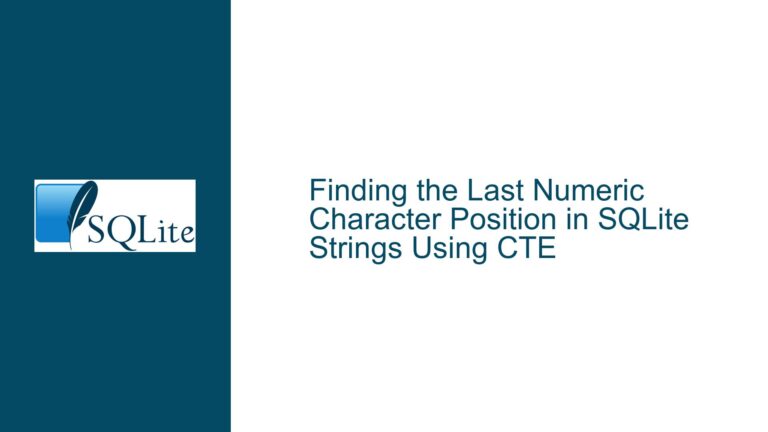Extra Values Outputted with Partial Index and DISTINCT Constraints in SQLite
Unexpected Duplicate Values in SELECT DISTINCT Queries with Partial Indexes
When working with SQLite databases, a common expectation is that the DISTINCT keyword will eliminate duplicate rows from the result set of a query. However, under specific conditions involving partial indexes, this expectation can be violated, leading to unexpected duplicate values in the output. This issue arises when a UNIQUE partial index is defined on a column, and a SELECT DISTINCT query is executed with a WHERE clause that aligns with the partial index’s condition. The result is that the DISTINCT constraint appears to be ignored, causing duplicate values to appear in the output.
To understand this issue, consider the following example schema and queries:
CREATE TABLE person (pid INT);
CREATE UNIQUE INDEX idx ON person (pid) WHERE pid = 1;
INSERT INTO person VALUES (1), (10), (10);
SELECT DISTINCT pid FROM person;
SELECT DISTINCT pid FROM person WHERE pid = 10;
In this scenario, the first SELECT DISTINCT query returns the expected result: 1 and 10. However, the second SELECT DISTINCT query, which includes a WHERE pid = 10 clause, unexpectedly returns two instances of 10 instead of one. This behavior is counterintuitive, as the DISTINCT keyword should ensure that duplicate values are removed from the result set.
The root cause of this issue lies in an optimization within SQLite that incorrectly omits the DISTINCT clause under certain conditions. Specifically, SQLite assumes that the DISTINCT clause is unnecessary if all terms in the result set are non-NULL and are elements of a UNIQUE index. However, this optimization fails to account for the possibility that the UNIQUE index might be a partial index, leading to the incorrect handling of the DISTINCT constraint.
Incorrect Optimization of DISTINCT Clause with Partial Indexes
The unexpected behavior in the SELECT DISTINCT query is caused by an incorrect optimization within SQLite’s query processing engine. This optimization is designed to improve query performance by eliminating unnecessary operations, such as the DISTINCT clause, when certain conditions are met. However, in the case of partial indexes, this optimization leads to incorrect results.
The optimization in question works as follows: when SQLite encounters a SELECT DISTINCT query, it checks whether all terms in the result set are non-NULL and whether they are elements of a UNIQUE index. If both conditions are met, SQLite assumes that the DISTINCT clause is redundant and omits it from the query execution plan. This assumption is generally valid for full indexes, where the UNIQUE constraint applies to all rows in the table. However, it breaks down when dealing with partial indexes, where the UNIQUE constraint only applies to a subset of rows.
In the example provided, the UNIQUE partial index is defined on the pid column with the condition WHERE pid = 1. This means that the UNIQUE constraint only applies to rows where pid is 1. When the SELECT DISTINCT query includes a WHERE pid = 10 clause, SQLite incorrectly assumes that the DISTINCT clause is unnecessary because the pid values are non-NULL and are part of a UNIQUE index. However, since the UNIQUE index is partial and does not apply to rows where pid is 10, the DISTINCT clause is incorrectly omitted, leading to duplicate values in the result set.
This issue highlights a subtle but important distinction between full and partial indexes in SQLite. While full indexes apply their constraints to all rows in the table, partial indexes only apply their constraints to a subset of rows. As a result, optimizations that are valid for full indexes may not be valid for partial indexes, leading to unexpected behavior in certain queries.
Resolving the Issue with PRAGMA journal_mode and Index Constraints
To address the issue of unexpected duplicate values in SELECT DISTINCT queries with partial indexes, it is necessary to modify the way SQLite handles the DISTINCT clause in the presence of partial indexes. This can be achieved through a combination of changes to the database schema and the use of SQLite’s PRAGMA statements to control the database’s behavior.
One approach to resolving this issue is to avoid using partial indexes in scenarios where the DISTINCT clause is likely to be used with a WHERE clause that does not align with the partial index’s condition. In the example provided, the partial index is defined with the condition WHERE pid = 1, but the SELECT DISTINCT query includes a WHERE pid = 10 clause. Since the partial index does not apply to rows where pid is 10, the DISTINCT clause is incorrectly omitted. By avoiding the use of partial indexes in such scenarios, it is possible to prevent this issue from occurring.
Another approach is to modify the query to explicitly enforce the DISTINCT constraint, even when SQLite’s optimization would otherwise omit it. This can be achieved by using a subquery or a GROUP BY clause to ensure that duplicate values are removed from the result set. For example, the following query uses a subquery to enforce the DISTINCT constraint:
SELECT pid FROM (SELECT DISTINCT pid FROM person WHERE pid = 10);
This approach ensures that the DISTINCT constraint is applied correctly, regardless of whether SQLite’s optimization would otherwise omit it.
In addition to modifying the query, it is also possible to use SQLite’s PRAGMA statements to control the database’s behavior and prevent the incorrect optimization from occurring. Specifically, the PRAGMA journal_mode statement can be used to enable or disable certain optimizations that may affect the handling of the DISTINCT clause. For example, setting the journal_mode to WAL (Write-Ahead Logging) can improve the database’s performance and reliability, while also ensuring that the DISTINCT clause is handled correctly in the presence of partial indexes.
Finally, it is important to ensure that the database schema is designed in a way that minimizes the risk of encountering this issue. This includes carefully considering the use of partial indexes and ensuring that they are only used in scenarios where they are truly necessary. By following best practices for database schema design and query optimization, it is possible to avoid the issue of unexpected duplicate values in SELECT DISTINCT queries with partial indexes.
In conclusion, the issue of unexpected duplicate values in SELECT DISTINCT queries with partial indexes is caused by an incorrect optimization within SQLite’s query processing engine. This optimization incorrectly omits the DISTINCT clause when certain conditions are met, leading to duplicate values in the result set. To resolve this issue, it is necessary to modify the database schema, adjust the query, and use SQLite’s PRAGMA statements to control the database’s behavior. By following these steps, it is possible to ensure that the DISTINCT constraint is applied correctly and that the query results are as expected.






